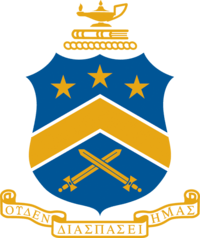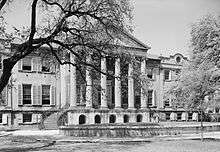Pi Kappa Phi
| Pi Kappa Phi | |
|---|---|
| ΠΚΦ | |
 | |
| Founded |
December 10, 1904 College of Charleston |
| Type | Social, Secret |
| Scope | United States |
| Mission statement | To create an uncommon and lifelong brotherhood that develops leaders and encourages service to others for the betterment of our communities. |
| Vision statement | A future where every Pi Kappa Phi embraces his role as a leader, puts service before self and improves the world around him.[1] |
| Motto |
ΟΥΔΕΝ ΔΙΑΣΠΑΣΕΙ ΗΜΑΣ "Nothing shall ever tear us asunder" |
| Colors | White, Gold, Royal Blue |
| Symbol | Bell, Star & Lamp |
| Flower | Red Rose |
| Jewel | Diamond |
| Publication | The Star and Lamp |
| Philanthropy | The Ability Experience |
| Chapters | 231 (187 active)[2] |
| Colonies | 19[3] |
| Members |
9,892 (as of 2013)[2] collegiate 113,148 (as of 2013)[2] lifetime |
| Headquarters |
2015 Ayrsley Town Blvd Ste #200 P.O. Box 240526 Charlotte, North Carolina |
| Homepage |
www |
Pi Kappa Phi (ΠΚΦ; also Pi Kapp or PKP) is an American Greek Letter secret and social fraternity. It was founded by Andrew Alexander Kroeg Jr., Lawrence Harry Mixson, and Simon Fogarty Jr. on December 10, 1904 at the College of Charleston in Charleston, South Carolina. The fraternity has 179 active chapters (160 chartered chapters and 19 associate chapters),[2][3] and more than 113,000 initiated members.[2][4]
Pi Kappa Phi operates in four entities: Pi Kappa Phi Fraternity, Pi Kappa Phi Foundation, The Ability Experience, and Pi Kappa Phi Properties.
Pi Kappa Phi operates its own philanthropy, The Ability Experience (formerly known as Push America), which works with individual chapters to serve people with disabilities.[5]
History
Nu Phi
Pi Kappa Phi was founded in 1904 by Andrew Alexander Kroeg Jr., a 19-year-old senior at the college; Simon Fogarty Jr., a 17-year-old junior; and Lawrence Harry Mixson, a 16-year-old sophomore. All three of the men were from Charleston.
In 1904, the College of Charleston was a small, municipal college. The all-male college was the first to be supported solely by city funds, and the eleventh oldest in the United States. The school had a campus literary society called the Chrestomathics, which held activities such as debates. The college's monthly magazine was staffed by the officers of the Chrestomathics, forming the equivalent of a modern-day student government.
The three men set a goal to obtain officer positions within the Chrestomathic Literary Society. At that time, the organization was dominated by the three chapters of national fraternities on campus. All fraternity men were sworn to vote for their candidates, making it virtually impossible for any non-fraternity men to win election.
Kroeg, Mixson, Fogarty, and a group of their friends, all non-fraternity men, began forming an opposition party. Several meetings were held at Mixson's home on Wentworth Street leading to the formation of Nu Phi, which stood for "non-fraternity." The group of 15 men developed an opposing slate and began campaigning. Nu Phi adopted the outline of a hand as its secret symbol. A sketched hand on a classroom chalkboard signified an upcoming meeting. Inside the hand was written the meeting time and the host's last name.
The Nu Phi group assigned a member to kidnap those who might vote for the fraternity ticket on election day. However, the Nu Phi ticket lost the elections. Later, it was revealed that several disloyal members cast their votes for the opposing fraternity slate. Kroeg, determined to see his friends have a chance at winning elections, decided that the only way to gain the influence of the fraternity men on campus was to begin his own fraternity.[6]
Founding

On December 10, 1904, a meeting of the loyal Nu Phis was held at Fogarty's home at 90 Broad Street to establish a new fraternity. There were seven men in attendance at the meeting: Kroeg, Fogarty, Mixson, Anthony Pelzer Wagener, Thomas F. Mosimann, Theodore ("Teddy") Barnwell Kelley, and James Fogarty (Simon's younger brother). All of the original members were students at the college and had grown up together in Charleston.[6]
Wagener, who was a student of Greek and Latin, recommended the letters Pi Kappa Phi and their secret meaning as the official new name of the group. Simon proposed the design of the fraternity's pin, a black enamel diamond with the Greek letters ΠΚΦ engraved in gold with a star and lamp as additional elements. Kroeg was selected as the new chapter's first president, which was termed "Archon", from the Greek term. He then began work on a constitution for chapter. The group quickly set out to recruit new members to its ranks.[6]
On December 10, 1905, the first anniversary of the fraternity's founding, Mixson's mother cooked the men a special dinner in her home to celebrate a successful first year as a fraternity. The fraternity celebrate that date as "Founders Day" with a dinner or a similar ceremony. In 1906 Mixson and Wagener wrote the fraternity's initiation ritual as the "highest ideals of Christian manhood".[6]
Expansion
That same year, the group was offered a charter from another U.S. fraternity. Instead, they chose to expand and create more Pi Kappa Phi chapters. A second chapter ("Beta Chapter") was formed at Presbyterian College on March 9, 1907. Due to a state law banning fraternities at state supported schools, Presbyterian College and the College of Charleston were the only two South Carolina schools where fraternities were allowed. A third chapter was formed at the University of California, Berkeley, which was the first chapter to obtain a house.
Kroeg developed "Articles of Incorporation" and the name Pi Kappa Phi became legally registered in the state of South Carolina on December 23, 1907.
The interest in Pi Kappa Phi within South Carolina was growing despite laws and policies banning fraternities. In 1909, Delta Chapter at Furman University formed and operated in secret until state laws changed, allowing fraternal organizations. In 1910, a charter was granted to Sigma Chapter at the University of South Carolina and the chapter was operated as the Sigma Club due to the laws banning fraternities.[6]
The Star and Lamp
The Pi Kappa Phi Fraternity Journal was begun in 1909, with Henry Wagener as editor. In 1911, the name was changed to the Star & Lamp.[6]
Controversies
In 2016, the fraternity at the Miami University was suspended for multiple hazing and alcohol violations.[7]
In 2016, four fraternity members at Radford University were arrested for hospitalizing a pledge after a hazing ritual.[8]
In 2015, the chapter at Pennsylvania State University was shut down for hazing pledges, alcohol abuse, and disorderly conduct.[9]
An alleged pledge notebook of Pi Kappa Phi's North Carolina State University chapter was found in Raleigh. It contained numerous racist statements and comments about raping women and girls. The national organization placed the chapter on an interim suspension. NCSU suspended all social events at the chapter that involved alcohol.[10][11]
A student pledging the California State University, Northridge chapter of Pi Kappa Phi died in the summer of 2014 during a mandatory 18-mile hike in what his family alleges was a hazing ritual.[12] Nineteen-year-old Armando Villa died during the trip to the Angeles National Forest. Villa's family reported that other boys on the hike said they were "left barefoot with very little water to share between the boys, and no cellphones, and to find their way out of the forest."[13] The police reported that the fraternity was cooperating with the police investigation and that chapter activities had been suspended until the investigation concluded.[14] In September 2014, the University announced that the national and local chapters of the Pi Kappa Phi fraternity voted to withdraw permanently from the university.[15] The fraternity is being sued by Villa's family.
In Spring 2015, the fraternity at the Elon University was kicked off the campus until 2017 for hazing and hosting an unapproved event.[16]
In December 2013, two Pi Kappa Phi members were arrested and charged with harassment at the University of Tennessee at Knoxville. The fraternity members were retaliating against a former pledge who reported to school officials physical and verbal abuse he experienced while he was seeking to join the fraternity.[17]
In 2012, the fraternity at the University of North Florida was suspended after asking a pledge to vandalize the campus and offering him marijuana.[18]
In 2010, the fraternity at the University of Georgia (UGA) was suspended after a father of a pledge wrote an anonymous letter to UGA's Greek Life Office detailing the abusive hazing rituals his son endured in order to be fully welcomed into the fraternity.[19]
In 2000, the California State University, Chico chapter was dissolved and later permanently banned after the alcohol-related hazing death of freshman student Adrian Heideman.[20] In response to Heideman's death the national chapter created an alcohol-awareness video for distribution to all members, "The Choice Is Yours." [21]
Alumni
Chapters
.jpg)
As of 2013 Pi Kappa Phi reports having over 113,000 members.[2] Pi Kappa Phi has granted 231 charters, with an average chapter size of 55. There are 160 active chartered chapters plus 19 associate chapters (colonies).[2][3]
See also
References
- Sheetz, George; Leake, Howard; Buffington, Perry; Timmes, Mark; Owen, Durward; de Palma, Leonard (2004). "The Brotherhood: History of Pi Kappa Phi (1904-2004)". Pi Kappa Phi Fraternity.
- Erickson, Evan; Sullivan, TJ (2002). "The White Diamond of Pi Kappa Phi Fraternity: A Guide to Brotherhood". Charlotte, North Carolina: Pi Kappa Phi Fraternity.
- ↑ "Our Mission & Vision". Pi Kappa Phi. Retrieved 25 February 2015.
- 1 2 3 4 5 6 7 "Basic Information: By the numbers". Pi Kappa Phi Fraternity. Retrieved 16 June 2014.
- 1 2 3 "Chapter Locator". Pi Kappa Phi Fraternity. Retrieved 18 February 2013.; as revised/updated by: "Expansion Calendar". Pi Kappa Phi Fraternity. Retrieved 18 February 2013.
- ↑ "Pi Kapp Facts". Archived from the original on 20 August 2009.
- ↑ "Journey of hope". Push America. Retrieved 2007-12-17.
- 1 2 3 4 5 6 "Non fraternity". Pi Kappa Phi. Archived from the original on 2008-10-30. Retrieved 2007-12-17.
- ↑ http://www.cincinnati.com/story/news/2016/04/19/miami-u-suspends-2-fraternities-hazing/83233532/
- ↑ http://www.wdbj7.com/content/news/Four-Radford-University-fraternity-brothers-arrested-on-hazing-charges-378268671.html
- ↑ http://www.pennlive.com/midstate/index.ssf/2015/04/penn_state_fraternity_suspende_1.html
- ↑ "NC State, Pi Kappa Phi decry 'unacceptable and offensive' book>". Retrieved 2015-05-29.
- ↑ "Fraternity Suspended Over Notebook Detailing Rape And Lynching>". Retrieved 2015-05-29.
- ↑ "Family sues after fraternity pledge's death on hazing hike". Retrieved 2015-08-13.
- ↑ "Family of CSUN Student Who Died on Fraternity Trip Wants Justice: "They Left Him There to Die"". NBC LA."Cal State Northridge fraternity pledge dies after alleged 'hazing' hike". LATimes.
- ↑ Greig, Alex (July 3, 2014). "'Fraternity hazing ritual' blamed for death of student, 19, who was found without shoes or cell phone in forest". Daily Mail UK.
- ↑ Owens, Caitlin; Vives, Ruben (September 5, 2014) "Cal State Northridge fraternity shuts after pledge's death" Los Angeles Times http://www.latimes.com/local/lanow/la-me-ln-csun-fraternity-closing-pledge-death-20140905-story.html
- ↑ http://www.wxii12.com/news/elon-university-shuts-down-pi-kappa-phi-through-2017/31951288
- ↑ http://www.knoxnews.com/news/police-arrest-second-ut-student-in-fraternity
- ↑ http://www.news4jax.com/news/UNF-suspends-Pi-Kappa-Phi-fraternity-for-hazing/8774828
- ↑ http://www.redandblack.com/uganews/greeklife/the-other-side-of-the-paddle-one-sorority-member-talks/article_018cbe86-2e37-11e4-a8a8-0017a43b2370.html
- ↑ http://www.farmhouse.org/pdf/FRMT.pdf
- ↑ https://www.youtube.com/watch?v=koA5iFT_7h0
